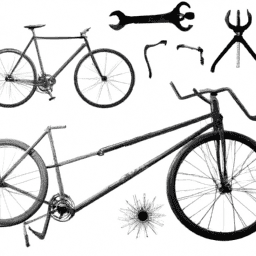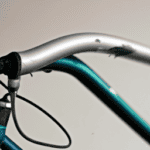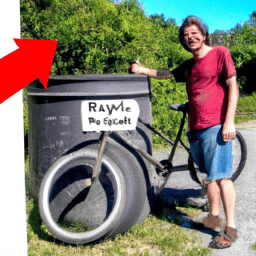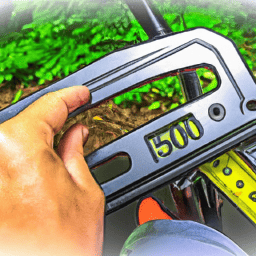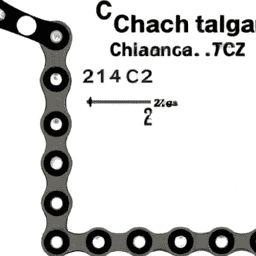As someone passionate about cycling, I understand that bringing an old bicycle back to life can offer a great sense of fulfillment and satisfaction. Nevertheless, it’s crucial to take into account the restoration expenses before diving into the project.
The cost of restoring a bicycle can vary greatly depending on a number of factors, including the extent of the damage, the level of restoration desired, and the cost of replacement parts.
The first step in determining the cost of restoring a bicycle is to assess the damage. This can include checking for rust, cracks, and other visible damage, as well as inspecting the bike’s mechanical components.
Once the damage has been assessed, it is important to consider the cost of basic restoration, including cleaning and repainting the frame, replacing worn or damaged tires, and tuning the gears and brakes.
From there, additional costs can be incurred if the owner decides to upgrade components, such as replacing the handlebars or upgrading to a more advanced drivetrain.
While restoration costs can quickly add up, there are ways to save money on the project, such as doing the work oneself or seeking out used parts.
Key Takeaways
- Assessing the damage is crucial in determining the cost of restoration.
- Upgrading components and shopping around for parts can add to the cost, but can also save money.
- DIY restoration can save on labor costs, but professional services offer expert guidance.
- The quality of replacement parts and cost-benefit of upgrades should be considered, and upgrading in stages can spread out the cost.
Assessing the Damage
So, you’ve taken a closer look at your bicycle and you’re probably wondering, "What kind of damage are we looking at here?"
Well, the first step in assessing the damage is to look for any frame damage. This can include cracks, dents, or bends in the frame. If there’s any damage to the frame, it can be quite costly to repair. Depending on the extent of the damage, it may require welding or even a full replacement of the frame. It’s important to take this into account when considering the overall cost of restoring your bike.
Another thing to look out for when assessing the damage is rust. Rust can be a common issue with older bikes and can cause damage to the frame, as well as other components of the bike. There are various rust removal techniques that can be used, such as sandblasting or chemical treatments. However, these techniques can also add to the overall cost of restoration. It’s important to properly assess the extent of the rust and determine the best course of action for removal.
With these factors in mind, it’s important to consider the basic restoration costs of your bike.
Basic Restoration Costs
You’ll be pleasantly surprised by how affordable it is to give your bike a basic restoration. Here are three ways to keep the costs low:
-
DIY restoration: Doing the restoration yourself is the most cost-effective option. You can save on labor costs and choose which parts to replace or repair. All you need are some basic tools and knowledge of bike mechanics. There are plenty of online tutorials and bike repair books to guide you through the process.
-
Professional services: If you’re not confident in your restoration skills, you can hire a professional bike mechanic. This will cost more than a DIY restoration, but you’ll get expert guidance and a guarantee that the job is done correctly. You can also choose which services to pay for, such as tune-ups or specific repairs.
-
Shop around for parts: Whether you DIY or hire a professional, you can save money by shopping around for parts. You can find new or used parts online or at local bike shops. Compare prices and quality before making your purchase.
Upgrading components can add to the cost of your restoration, but it’s worth considering if you want to improve the performance of your bike.
Upgrading Components
When it comes to restoring a bicycle, one of the most important aspects is upgrading the components. This involves replacing outdated or damaged parts with new ones, upgrading to higher-quality components, and considering the cost-benefit of upgrades.
As someone who’s restored several bicycles, I know firsthand the importance of ensuring that the components are in good working order and how upgrading can greatly improve the overall performance and appearance of the bike.
Replacing outdated or damaged components
If your bike’s brake pads are battered beyond belief, it may be time to replace them to restore your ride’s reliability. When considering replacing outdated or damaged components on your bike, there are a few things to keep in mind.
-
Repair vs Replacement: It can often be difficult to determine whether a repair or replacement is necessary when it comes to replacing bike components. Consider the extent of the damage and the age of the component. If the component is outdated or worn beyond repair, it may be best to replace it altogether.
-
DIY vs Professional: Another factor to consider is whether to perform the replacement yourself or seek professional help. If you have experience with bike maintenance and feel confident in your abilities, a DIY replacement may save you money. However, if you are unsure or do not have the necessary tools, it may be best to take your bike to a professional to ensure proper installation and avoid further damage.
-
Quality of Replacement Parts: When choosing replacement parts, it is important to consider the quality of the component. While it may be tempting to opt for cheaper parts, investing in higher-quality components can pay off in the long run with increased durability and reliability.
Replacing outdated or damaged components is an important aspect of restoring your bike’s overall performance. However, upgrading to higher-quality parts can take your ride to the next level.
Upgrading to higher-quality parts
To enhance your cycling experience, upgrading to higher-quality components can greatly improve your ride. When choosing components, consider what type of riding you’ll be doing and how much you’re willing to spend.
Upgrading your bike can be an expensive investment, but it can also provide significant performance gains. When upgrading, start with the components that will make the biggest difference in your ride quality.
For example, upgrading your wheels can improve your bike’s speed and handling, while upgrading your drivetrain can improve shifting and reduce overall weight. Additionally, investing in a higher-quality saddle and handlebars can greatly improve your comfort while riding.
Considering the cost-benefit of upgrades, it’s important to weigh the potential performance gains against the cost of the components. While upgrading to higher-quality parts can improve your cycling experience, it may not always be necessary or cost-effective.
By carefully selecting the components you wish to upgrade and considering the cost, you can make informed decisions that will ultimately improve your ride without breaking the bank.
Considering the cost-benefit of upgrades
Upgrading your bike with higher-quality components can greatly enhance your cycling experience, but it’s important to carefully weigh the potential performance gains against the investment.
Here are some upgrading techniques and budgeting strategies to consider before you start spending money on upgrades:
-
Upgrade in stages: Instead of upgrading everything at once, prioritize the components that will have the biggest impact on your riding experience, such as the drivetrain or wheels. This will allow you to spread out the cost over time and avoid spending money on upgrades that may not be as beneficial.
-
Consider used or older models: You can often find high-quality components from previous years that are still in great condition for a fraction of the cost of brand new components. This can be a great way to upgrade without breaking the bank.
When considering upgrades, it’s important to keep in mind that the cost of the components is just one part of the equation. You will also need to factor in the cost of labor to install the components, which can add up quickly.
Labor Costs
Labor costs for restoring a bicycle can be a significant portion of the total cost. The average hourly rate for a bicycle mechanic ranges from $50 to $90 per hour. However, the amount of labor required for restoring a bike varies greatly depending on the extent of the repairs needed.
Common repairs, such as replacing brake pads or adjusting the derailleur, can be easily done by a DIY enthusiast. But more complex repairs, such as wheel truing or bottom bracket replacement, may require the expertise of a professional mechanic.
It’s important to keep in mind that labor costs can quickly add up, especially if multiple repairs are needed. However, there are ways to save money on restoration by doing some of the work yourself or by purchasing used parts.
In the next section, we’ll explore some cost-saving measures that can help you restore your bike without breaking the bank.
Saving Money on Restoration
You can keep more money in your pocket during the restoration process by utilizing some budget-friendly tips and DIY solutions.
One of the easiest ways to save money is to do as much of the restoration work as possible yourself. This includes tasks such as removing the old paint, cleaning the bike, and replacing the cables.
You can also save money on parts by purchasing used or refurbished parts instead of brand new ones. Look for local bike shops or online marketplaces where you can find quality parts for a fraction of the cost.
Another cost-saving measure is to repurpose items around your house for bike restoration. For example, you can use old toothbrushes to clean small parts, or use household vinegar to remove rust from metal components. Additionally, you can use inexpensive household items like baking soda and lemon juice to shine up chrome.
By getting creative and using what you already have, you can save money on specialized cleaning products and tools. With a little bit of research and some elbow grease, you can restore your bike without breaking the bank.
Frequently Asked Questions
Can I restore a bicycle myself or should I hire a professional?
When it comes to restoring a bicycle, the decision to DIY or hire a professional depends on your skill level and budget. While DIY can be cost-effective, it’s important to weigh the potential risks and time commitment.
How long does the restoration process usually take?
Factors affecting restoration timeline include the extent of damage, availability of replacement parts, and complexity of repairs. Proper cleaning techniques are crucial for optimal results. Depending on these factors, restoration can take anywhere from a few hours to several days.
Is it worth it to restore an old or vintage bicycle?
Restoring a vintage bicycle can be a labor of love, worth every penny. Look for quality materials, craftsmanship, and a design that speaks to you. Finding one may take time, but the emotional value of restoring it is priceless.
What are some common mistakes to avoid when restoring a bicycle?
When restoring a bicycle, common mistakes include using the wrong sandpaper selection, not properly preparing the paint, and not replacing worn out parts. Thoroughness and attention to detail are key to a successful restoration.
How frequently should I maintain my restored bicycle to keep it in good condition?
To keep my restored bicycle in good condition, I aim for monthly maintenance. I use Tips for DIY maintenance, such as cleaning and lubing the chain, and also benefit from professional tune ups every six months.
Conclusion
In conclusion, restoring a bicycle can be a great way to save money and breathe new life into an old ride. After assessing the damage and determining the necessary repairs, basic restoration costs can range from $50-$200. Upgrading components such as the drivetrain or wheels can add an additional $100-$500 to the cost.
It’s important to also factor in labor costs, as a professional bike mechanic can charge anywhere from $50-$100 per hour. However, with some research and a bit of DIY effort, it’s possible to save money on restoration by doing some of the work yourself.
According to a recent study, the average American spends $1,200 on transportation costs per year. By restoring a bicycle instead of buying a new one or using a car for short trips, you can potentially save hundreds of dollars annually. Plus, with the added benefit of exercise and reduced carbon emissions, restoring a bicycle is a win-win situation for both your wallet and the environment.
So, dust off that old bike in your garage and start restoring it today!
